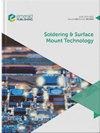倒装芯片封装中底部填充流动的空间分析
IF 1.8
4区 材料科学
Q3 ENGINEERING, ELECTRICAL & ELECTRONIC
引用次数: 9
摘要
目的本研究的目的是研究倒装芯片封装过程中底部填充流动的空间方面,例如弯月面演变和接触线跳跃(CLJ)。此外,还建立了底部填充流动过程中基于空间的空隙形成机制。设计/方法/方法使用微网格单元方法对凸块阵列和CLJ现象之间的底部填充流体的弯液面演变进行了数值可视化。此外,基于毛细管物理学的公式,对弯月面演化和CLJ现象进行了分析建模。同时,对孔隙的形成机理进行了数值和解析解释。结果所提出的分析结果和当前的数值结果都达成了很大的共识,并得到了很好的实验验证。分析了凸点间距对空间方面的变化影响,发现弯月弧半径和填充距离随着间距的增加而增加,而弯月弧的对向角随着间距的大小而不变。对于较大的节距,跳跃发生在离凸块入口更远的地方,并且需要更长的时间才能达到平衡弯液面。由此推断,弯月面弧的凹度受凸点间距的影响。在空隙形成机理上,由于流体与凸块的相互作用,空气截留形成了空隙。较小的空隙往往通过颈缩合并成较大的空隙,随后沿着底部填充流传播。实际意义底部填充流的微观空间分析将从根本上解释凸起设计将如何影响宏观填充时间。这不仅为分析行业中的流动模式提供了替代的可视化工具,而且能够开发准确的分析填充时间模型。此外,孔隙形成机制为理解孔隙缺陷的根本原因提供了实质性的见解,并允许制定可能的解决方案来解决这个问题。此外,微流体领域也可以从这些空间分析见解中受益。原创性/价值由于以往的研究主要侧重于时间方面,因此很少对欠充流量进行空间分析。此外,这项工作提出了一种基于流体-凸起相互作用的孔隙形成新机制,其中首次对微孔隙的形成和传播进行了数值可视化。当前工作的发现为封装设计者的优化工作和工艺增强提供了关于底部填充流体和焊料凸块之间的流动相互作用的基本信息。本文章由计算机程序翻译,如有差异,请以英文原文为准。
Spatial analysis of underfill flow in flip-chip encapsulation
Purpose
The purpose of the study is to investigate the spatial aspects of underfill flow during the flip-chip encapsulation process, for instance, meniscus evolution and contact line jump (CLJ). Furthermore, a spatial-based void formation mechanism during the underfill flow was formulated.
Design/methodology/approach
The meniscus evolution of underfill fluid subtended between the bump array and the CLJ phenomenon were visualized numerically using the micro-mesh unit cell approach. Additionally, the meniscus evolution and CLJ phenomenon were modelled analytically based on the formulation of capillary physics. Meanwhile, the mechanism of void formation was explained numerically and analytically.
Findings
Both the proposed analytical and current numerical findings achieved great consensus and were well-validated experimentally. The variation effects of bump pitch on the spatial aspects were analyzed and found that the meniscus arc radius and filling distance increase with the pitch, while the subtended angle of meniscus arc is invariant with the pitch size. For larger pitch, the jump occurs further away from the bump entrance and takes longer time to attain the equilibrium meniscus. This inferred that the concavity of meniscus arc was influenced by the bump pitch. On the voiding mechanism, air void was formed from the air entrapment because of the fluid-bump interaction. Smaller voids tend to merge into a bigger void through necking and, subsequently, propagate along the underfill flow.
Practical implications
The microscopic spatial analysis of underfill flow would explain fundamentally how the bump design will affect the macroscopic filling time. This not only provides alternative visualization tool to analyze flow pattern in the industry but also enables the development of accurate analytical filling time model. Moreover, the void formation mechanism gave substantial insights to understand the root causes of void defects and allow possible solutions to be formulated to tackle this issue. Additionally, the microfluidics sector could also benefit from these spatial analysis insights.
Originality/value
Spatial analysis on underfill flow is scarcely conducted, as the past research studies mainly emphasized on the temporal aspects. Additionally, this work presented a new mechanism on the void formation based on the fluid-bump interaction, in which the formation and propagation of micro-voids were numerically visualized for the first time. The findings from current work provided fundamental information on the flow interaction between underfill fluid and solder bump to the package designers for optimization work and process enhancement.
求助全文
通过发布文献求助,成功后即可免费获取论文全文。
去求助
来源期刊

Soldering & Surface Mount Technology
工程技术-材料科学:综合
CiteScore
4.10
自引率
15.00%
发文量
30
审稿时长
>12 weeks
期刊介绍:
Soldering & Surface Mount Technology seeks to make an important contribution to the advancement of research and application within the technical body of knowledge and expertise in this vital area. Soldering & Surface Mount Technology compliments its sister publications; Circuit World and Microelectronics International.
The journal covers all aspects of SMT from alloys, pastes and fluxes, to reliability and environmental effects, and is currently providing an important dissemination route for new knowledge on lead-free solders and processes. The journal comprises a multidisciplinary study of the key materials and technologies used to assemble state of the art functional electronic devices. The key focus is on assembling devices and interconnecting components via soldering, whilst also embracing a broad range of related approaches.
 求助内容:
求助内容: 应助结果提醒方式:
应助结果提醒方式:


